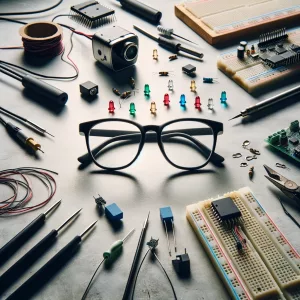And how to mitigate its influence on behavioral studies.
The Observer Effect impacts behavioral studies by altering participants’ actions when they know they’re being observed. To mitigate this, researchers can use strategies like physiological measures, habituation, naturalistic observation, blinding, computer-based testing, and pilot testing. These methods help ensure more authentic behavior and reliable data, improving the validity of research findings.
Table of Contents
“You are being observed.”
That phrase will prompt many of us to immediately reflect on our actions. The awareness of being watched often triggers self-monitoring, which typically results in a swift adjustment of behavior. Remarkably, this process can occur even if you merely believe that you are being observed.
Imagine walking into a conference room for a job interview and noticing a camera discreetly mounted in the corner. Suddenly, you might sit up straighter, choose your words more carefully, and become hyper-aware of every gesture and expression. This shift in behavior, spurred by the awareness of being observed, is a simple illustration of the Observer Effect—a phenomenon that can profoundly impact human behavior research.

The Observer Effect, a well-documented challenge in the field of human behavior research as well as in “real” world situations, refers to the tendency of individuals to alter their behavior when they know they are being observed. This effect can skew research findings, making it difficult to capture authentic actions and interactions. However, as researchers dedicated to uncovering genuine human behaviors, strategies to mitigate this effect and gather reliable data must be built into every study design.
Understanding the Observer Effect
The Observer Effect is not merely a theoretical concept but a tangible influence that can manifest in various ways. From subtle changes in facial expressions to significant alterations in task performance, the awareness of being observed can lead to a range of behavioral modifications. This awareness can increase self-consciousness and self-monitoring, causing participants to act in ways that are inconsistent with their natural behavior. Thereby rendering the data collected of less than ideal quality.
In human behavior research, where the goal is always to understand authentic actions and reactions, the Observer Effect poses a very real and significant threat to the validity of the data collected. It is essential to recognize the factors that contribute to this effect, such as the presence of recording devices, the observer’s demeanor, and even the knowledge of participation in a study.
Mitigation Strategies for Accounting for the Observer Effect in Lab-Based and Naturalistic Studies
Conducting lab-based studies presents unique challenges due to the artificiality of the setting and the heightened awareness participants have of being observed. However, there are several strategies researchers can employ to minimize the Observer Effect and ensure the validity of their data.
1. Physiological Measures
Physiological measures offer a robust approach to collecting data that is less susceptible to the conscious alteration associated with the Observer Effect. By focusing on involuntary physiological responses, researchers can gain insights into authentic reactions and behaviors that participants cannot consciously control or modify. This method allows researchers to remove themselves from being direct observers of behavior and instead rely on physiological data from participants as input. Here are two key strategies involving physiological measures:
1. Biosensors and Wearables
Biosensors and wearable devices have revolutionized the way researchers collect physiological data. These technologies can monitor a variety of physiological parameters in real-time, providing continuous and detailed insights into the body’s responses to different stimuli.
- Heart Rate Monitors: These devices measure the heart’s activity, providing data on heart rate variability (HRV), which can indicate stress levels, emotional arousal, and overall autonomic nervous system functioning. By monitoring heart rate continuously, researchers can track how participants’ physiological states fluctuate in response to specific tasks or stimuli in the lab.
- Galvanic Skin Response (GSR) Sensors: GSR sensors measure changes in skin conductivity, which vary with sweat gland activity. Since sweat gland activity is influenced by emotional arousal and stress, GSR can provide an indirect measure of psychological states. This data is valuable for understanding participants’ emotional reactions without relying on self-reported measures that might be influenced by the awareness of observation.
- Electroencephalography (EEG): EEG measures electrical activity in the brain, offering insights into cognitive processes, emotional states, and attention levels. By using EEG, researchers can observe how brain activity patterns change in response to different experimental conditions, providing objective data that participants cannot consciously alter.
- Wearable Fitness Trackers: Devices like fitness bands and smartwatches can measure a combination of physiological metrics, including heart rate, physical activity levels, and even sleep patterns. These wearables can continuously collect data in a less obtrusive manner, making them ideal for long-term studies where minimizing the Observer Effect is crucial.
2. Baseline Data Collection
Establishing baseline physiological data is crucial for distinguishing natural variability from changes induced by observation or experimental manipulations. Baseline data provides a reference point that helps researchers interpret the physiological responses observed during the study. This ensures that observations are made as comparisons to baseline behaviors and physiological responses, rather than as absolutes.
- Relaxed State Measurement: Before commencing the main experimental tasks, researchers should measure participants’ physiological metrics while they are in a relaxed state. This involves ensuring that participants are calm, comfortable, and free from external stressors. By doing so, researchers can capture the normal, resting levels of physiological activity, which serves as a control for subsequent measurements.
- Comparative Analysis: By comparing baseline data to data collected during the experimental tasks, researchers can identify deviations that are attributable to the experimental conditions rather than the mere presence of observation. This approach helps in isolating the effects of the experimental manipulations and provides a clearer understanding of how specific stimuli or tasks influence physiological responses.
- Longitudinal Baseline Data: In studies where participants are observed over extended periods, collecting baseline data at multiple points can account for natural fluctuations in physiological metrics due to time of day, stress, or other environmental factors. This repeated baseline measurement ensures that any observed changes are more likely to be due to the experimental conditions rather than extraneous variables.
2. Habituation
Habituation involves allowing participants time to get used to the lab environment and the observation process, reducing the fallacies that can occur during a single, isolated test or manipulation. This can be achieved by:
- Extended Pre-Study Exposure: Allowing participants to spend time in the lab and interact with the equipment and environment before the actual data collection begins.
- Repeated Measures: Using repeated measures designs where participants return to the lab multiple times, thus becoming more accustomed to the setting and less likely to modify their behavior.

3. Naturalistic Observation
Incorporating elements of naturalistic observation can help make the lab environment feel more familiar and less intrusive:
- Simulated Real-Life Environments: Designing the lab to closely resemble natural settings (e.g., mock living rooms, offices) can help participants feel more at ease and behave more naturally.
- Unobtrusive Observation Techniques: Using hidden cameras or one-way mirrors to observe participants without making them feel constantly watched can reduce the likelihood of behavior alteration.
4. Blinding Techniques
Blinding is essential in reducing the Observer Effect. In lab-based studies, single-blind and double-blind designs can be particularly effective.
- Single-Blind: Participants are unaware of the specific hypotheses or conditions being tested, which helps prevent them from altering their behavior based on what they think the researchers are looking for.
- Double-Blind: Both participants and experimenters are unaware of key aspects of the study (such as group assignments or specific hypotheses), which helps prevent experimenter bias from influencing the results.
5. Computer-Based Testing
Implementing computer-based testing and data collection can reduce direct human observation, which might help mitigate the Observer Effect:
- Automated Data Collection: Using software to administer tests and record responses can minimize the influence of an observer’s presence.
- Anonymity in Responses: Allowing participants to enter responses anonymously can reduce social desirability bias and encourage more honest behavior.
6. Pilot Testing and Feedback
Conducting pilot tests and seeking feedback from participants can help identify and address potential sources of the Observer Effect. Pilot studies offer flexibility, allowing researchers to explore various directions without the pressure to prove definitive findings. This iterative process not only refines the study design but also enhances the reliability of the results by mitigating biases and unexpected influences.
- Pilot Studies: Running preliminary versions of the experiment to observe how participants react and making adjustments to minimize awareness of observation.
- Participant Feedback: After the pilot study, collecting feedback on their experience and their awareness of being observed can provide insights into how to further reduce the Observer Effect.
Conclusion
Mitigating the Observer Effect in lab-based studies requires a combination of methodological rigor, creative design, and ethical considerations. By employing strategies such as blinding, habituation, naturalistic observation, ethical deception, physiological measures, computer-based testing, and pilot testing, researchers can minimize the impact of the Observer Effect and enhance the validity of their findings. These approaches ensure that the behavior observed in the lab is as close to natural behavior as possible, providing more reliable and meaningful data.
Free 52-page Human Behavior Guide
For Beginners and Intermediates
- Get accessible and comprehensive walkthrough
- Valuable human behavior research insight
- Learn how to take your research to the next level











